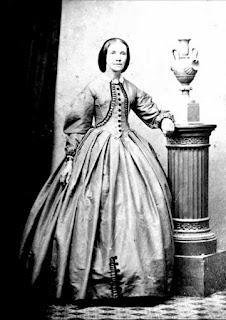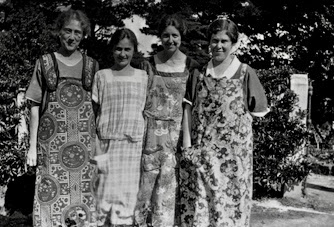32/52 Library: Mabel Joyce Godlee 1903 - 1998
32/52 Library: Mabel Joyce Godlee 1903 -1998
‘Mabel Joyce’ was never known as Mabel; in fact she is said to have hated that name. People called her Joyce, but she was Jay to family.
She lived to be a very old woman, in a nursing home. A librarian from the Burnside Library would visit the home regularly to bring her books. She had a keen mind, open to learning, until she died. The librarian got to know what she liked, serious literature, and provided it. I realise now that Jay was probably smarter than I knew. Her favourite author was Thomas Mann, the winner of the Nobel Prize for Literature in 1929. His 1921 novel, Magic Mountain was set in a sanitarium in Switzerland where in the 1930s Jay would find herself working as a nurse. Mann was a German intellectual who had to flee Germany during the war. In America he suffered under McCarthyism. Jay was a serious reader all her life and as a result, she was a progressive thinker. She was one of the first in the family of her generation to vote Labour.
There is a lot more to learn about Jay from the letters she sent home from England and Europe in the 1930s.. That pleasure awaits. Meanwhile this piece is about her life in the first period, her twenties.
Jay was the baby sister of Dots, Marge, Mary and Norkie, sixth child of Charlotte née Hobbs and Theodore Godlee. She was 4 in 1908 when her father died and 12 when her brother died in the first world war. So her’s became a largely women’s household although she did have a little brother, Tim. I have already written blogs about her mother and these sisters: Dots, Marge Mary Norkie.
I knew Jay when I was a small child. She was still living in an all woman household, with Norkie her sister. There was a room in the house for Mary too when she wasn’t travelling. We were picked up from our house in Burnside and Jay drove up the winding road to the hills. If there was a truck on the road we crawled up to Stirling. So different these days! Norkie and Jay lived in a beautiful house in a sprawling, wild and wonderful garden, the model garden that I aspire to today. A line of poplars shielded the house from the road and huge gums and pine trees towered over the bottom of the sloping block. There were masses of flowers and deciduous shrubs, paths meandering between the beds. It seemed enormous but I was under 4 so perhaps it wasn’t as big as it is in my mind. The house too was full of treasures from their travels: paintings, china, linen, ornaments. It was all very artistic and civilised.
Jay studied at Methodist Ladies College where she regularly received academic prizes, usually down the list after her best friend, Phyllis Lade. She was very involved in the Sunday School, Christian Endeavour and YWCA. She played the piano - Grieg’s ‘Butterfly’ and Bach are mentioned and she learned singing as well. When she was only 10 she performed at the Christian Endeavour Annual Social, singing Home Sweet Home.
Brother Tim and Jay, in school uniforms, with Dot's baby, Alison, 1917.
At the end of 1921 she graduated from high school in English Literature, Modern History and French. In the Speech Night address Miss Patchell, the Head Mistress, laments that too many girls are taken out of school too soon to help at home because of the difficulty of ‘obtaining suitable help in the home’. ‘We sympathise with the parents but hope they will solve the problem in some other way than by the sacrifice of their girls.’
Indeed when Joyce finished school she didn’t seem to have had a clear plan of a career. She didn’t go to university. When her older sisters had babies she went to help out in the house and care for other children, During that time her mother writes, ‘Of course I miss my right hand but I suppose I will survive.’ Housework was a lot more time consuming and laborious then and it needed more than one woman to keep things in hand. The Godlees did have a cook, Emily, and often a maid, Tilly, or Miss Mckenzie, but it still needed a team to get the washing done in the copper, the carpets cleaned, the meals on the table, as well as making jam and bottling fruit from the garden. The arrival of the ‘electric cleaner’ was something to write home about!
Mary, older than Jay by 6 years, had left home to work for the YWCA in Melbourne. Norkie was older than Jay by three years and she started to build a career in art, holding exhibitions and selling her china painting and watercolours. What was Jay going to do? She seems to have been given more domestic responsibility than Mary and Norkie, taking a greater role in housework, cooking and certainly sewing. A sample of Charlotte’s letters of the early 20s give us an idea of the breadth of her activities.
In a March 1924 letter Charlotte writes that Mary and Jay studying Ethics.
Poor old Jay is trying to get things clear enough to write an essay for next Tuesday and talks it over with me which you can guess is not much help. If I say ‘Oh yes, I see that’ she thinks it cannot be right as I see it so easily and if I cannot see it….
In the same letter to Margery she mentions
Jay has almost finished your dress. There is about 3/4 yd left. She thinks she could make a shirt out of it, if you do not need it.
And in April
Jay and I are busy making pyjamas for our man. [brother Tim]. She has quite a lot of dresses to make and does not want to be too busy at Christmas time.
In 1925 Charlotte has a breast cancer diagnoses and Jay has to take on more:
She is very well and is getting such a good cook. I think the added responsibility is developing her well.
This letter of July '26 gives us an idea of Jay’s life
Auntie and Jay go to church like good folk as they are. …. she seemed to have extra meetings. She really is not terribly rushed these days but there is always something to be done. She sent off Mary’s black velvet dress. …She seems to have an excess of parties. This week she made herself a costume for hockey, black Italian cloth with a wide band of pink and white check. She also wears a head band and tie for that and it really looks quite fetching. She loves the strenuous game. Now Phyl comes on Tuesday nights and goes off about seven for practice so Jay is up early one morning a week anyway.
At this time Norah hatches a plan to go to England. Jay made most of the clothes she took. (Jay has finished Norkie’s silk kimono.)
By July 1926 there is the first mention in Charlotte’s letters of Jay's plan to study nursing. Judy Symon, Jay’s niece, thinks that nursing was suggested to Jay by Charlotte who was keen for her girls to be financially independent. The idea was that Jay would work at the Tumby Bay Hospital to see if nursing suited her. Charlotte writes:.
She would love to come to you, [Marge in Tumby Bay,] but will not leave me for so long. …… Three years in the Adelaide would not mean midwifery, would it? Mary wants to come home next year and do a course at the University. I purposely have not told her about Jay as I am sure she would decide to come and afterwards might feel she had been obliged to come for that reason. She is welcome to come home but I will not urge her one way or the other. It is her life to make the best she can of it. Jay would hate to leave me, she says, and equally of course I should hate her going. On the other hand, it would help her in the hard beginning, for I do think nursing is hard. …. Well, we do not even know whether Tilly [the maid] will come. I would rather have her than a stranger. I have no doubt of Jay’s happiness with you, dear, and Sister. It would be ideal in many ways. I should be coming over quite a lot, I expect.
This tells us the importance of having one of the girls at home. If Joyce goes to Tumby Bay to study she would be supported by her sister, Marge. In that case, Mary would come back to Adelaide, but Charlotte doesn’t want Mary to feel obligated, so she doesn’t tell her about Joyce’s plan to leave. If Tilly stays, Charlotte will not need Mary or Jay. Then comes a letter from Tilly. Her family need her at home. Single girls at home are an asset.
She is not coming to me. Her people want her to stay with them and say surely they can give her a home between them. …I shall get a young girl, probably, and keep on Miss McKenzie. She is very good. I do not want Jay to change her plans. She is quite old enough now and later on might not feel like doing it. We are very happy together and in many ways it seems a pity to change but anyway I am not worrying. Neither is she.
As it turned out Jay worked at the Tumby Bay hospital as a ‘probation nurse’. It was she who gave Judy Symon her first bath. Charlotte travelled to England to be with Norkie and was away for most of 1927.
Charlotte died in 1928. On her death bed she is supposed to have said to Jay: ‘Look after Norkie.’
Jay built a successful career as a nurse. She did ‘look after Norkie’ - who was considered delicate and artistic. As I remember Jay did the cooking, and probably the cleaning, She was the gardener. She also did beautiful embroidery. And clearly she read. She was not unusual in this as books and libraries were central to all my family. It is a wonderful thing that when Jay was over 90 she was regularly visited by a librarian.
She died on the 14th of June, 1998, at 95, the last of her generation.
Inside the cover of the copy of Sense and Sensibility that I have inherited from Jay. She was given this book for her birthday when she was 22.







She sounds like a most interesting woman. Isn't it wonderful having letters? Lucky you. They add such a depth to biographies.
ReplyDeleteYes, I am so lucky to have the letters.
DeleteWhat an interesting portrayal as it is often so difficult to find details of females lives.
ReplyDeleteMy blog is all about women. I decided to focus on them for the 52 Ancestors in 52 Weeks. I was reading a book called The Creation of Patriarchy by Gerda Lerner and she was talking about the importance of knowing women's history. So that's what inspired me. Yes, it is much more difficult to find out about them. Thank you for your interest
Delete